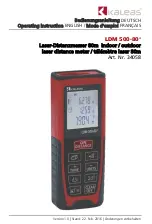
Device communication via the BMS bus
Device communication via the BMS bus
iso1685P_D00003_01_M_XXEN / 12.2016
27
8.2 Topology RS-485 network
The optimum topology for an RS-485 network is a daisy-chain connection. In this connec-
tion, device 1 is connected to device 2, device 2 to device 3, device 3 to device n etc. The
RS-485 network represents a continuous path without branches.
Correct arrangement
Three examples for correct arrangement:
Wrong arrangement
Three examples for wrong arrangement:
Wiring
The following type of wiring is recommended for the RS-485 network:
•
Shielded cable, core diameter
≥
0.8 mm
•
(e.g. J-Y(St)Y 2x0.8), shield connected to earth (PE) on one end.
•
Connection to terminals A and B.
The number of bus nodes is restricted to 32 devices. If more devices are to be connected,
Bender recommends the use of a DI1 repeater.
8.3 BMS protocol
This protocol is an essential part of the Bender measuring device interface (BMS bus pro-
tocol). Data transmission generally makes use of ASCII characters.
Interface data are:
•
Baud rate:
9600 baud
•
Transmission: 1 start bit, 7 data bits, 1 parity bit, 1 stop bit (1, 7, E, 1)
•
Parity:
even
•
Checksum:
sum of all transmitted bytes = 0 (without CR and LF)
The BMS bus protocol works according to the master-slave principle. Only one master
may exist in each network. All bus devices are identified by a unique BMS address. The
master cyclically scans all other slaves on the bus, listens to their signals and then carries
out the corresponding commands.
A device receives the MASTER function by assigning
Bus address 1
to it.
BMS master
A master can query all measured values, alarm and operating messages from a slave. If
bus address 1 is assigned to a device, this device automatically represents the master, i.e.
all addresses between 1 and 150 are cyclically scanned via the BMS bus for alarm and op-
erating messages. If the master detects incorrect answers from a slave, the fault message
"Fault RS-485" will be output via the BMS bus.
Fault causes may be:
•
Addresses are assigned twice
•
A second master exists on the BMS bus
•
Interference signals occur on the bus lines
•
A defective device is connected to the bus
•
Terminating resistors are not activated or connected
The iso1685P can only be operated as BMS SLAVE!













































